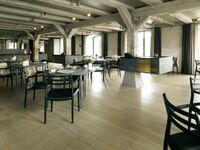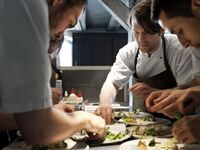Noma
This time, I happened to find myself in a realm far away, Copenhagen. The city might be cold and northern, but I discovered this amazing place and its extraordinary dishes. Let me share a bit about my time in the Danish capital. And if you go, will you like Noma as much as I did? So, what’s so special about this restaurant that sits a mere 40 at lunch and 40 for dinner?
 How did this Copenhagen restaurant, which has been named the top restaurant three times in a row, come out on top in a city where the sun, farming, and food diversity are below average? What’s more, the restaurant is located in an average neighborhood without any special view. It might be near the seaside, but a lot of things in Copenhagen are, so that’s not a stunning feat. Noma’s chef, Rene Redzepi, was born and raised in Copenhagen but is the child of a Macedonian family. He mainly cooks fish and vegetables, but he is also a stickler for using fresh food and really cares about using seasonal harvest. Accordingly, Rene offers a constantly changing and also narrow menu. Rene gets most of his ingredients from Denmark, only procuring some of his fish from further afield, like Greenland, Iceland, and the islands of South America. Noma still has just two Michelin stars, but it perhaps deserves a third. In 2019 Noma came second in the 50 best list. I’m sure next year they will get the top spot once again in its new location and will be included in “the best of the best” list forever. Located in a stone building, Noma boasts high ceilings and a fair degree of comfort. I had long wished to visit Noma but constantly failed to find a chance to book. But thanks again to the intervention of a friend, I was able to make a reservation for a Saturday night. And let me tell you, I couldn’t be happier.
How did this Copenhagen restaurant, which has been named the top restaurant three times in a row, come out on top in a city where the sun, farming, and food diversity are below average? What’s more, the restaurant is located in an average neighborhood without any special view. It might be near the seaside, but a lot of things in Copenhagen are, so that’s not a stunning feat. Noma’s chef, Rene Redzepi, was born and raised in Copenhagen but is the child of a Macedonian family. He mainly cooks fish and vegetables, but he is also a stickler for using fresh food and really cares about using seasonal harvest. Accordingly, Rene offers a constantly changing and also narrow menu. Rene gets most of his ingredients from Denmark, only procuring some of his fish from further afield, like Greenland, Iceland, and the islands of South America. Noma still has just two Michelin stars, but it perhaps deserves a third. In 2019 Noma came second in the 50 best list. I’m sure next year they will get the top spot once again in its new location and will be included in “the best of the best” list forever. Located in a stone building, Noma boasts high ceilings and a fair degree of comfort. I had long wished to visit Noma but constantly failed to find a chance to book. But thanks again to the intervention of a friend, I was able to make a reservation for a Saturday night. And let me tell you, I couldn’t be happier.
If you accompany your meal with wine, you might have to part with 500 euros for the whole affair. It might seem pricy, but considering how popular the restaurant is, quality and fame come at a price. Rene left school at the age of 15 and started studying culinary arts at a simple institution. After graduating, he began working in restaurants as a busboy. At the age of 20, he found work as a chef at a nice restaurant in France. After that, he made his way further south, heading to El Bulli, where he stayed for a couple of years and learned all one can about the ins and outs of the legendary Catalan restaurant. Looking for something new, he headed stateside for a new experience, succeeding in finding a job at Napa Valley’s The French Laundry, a world-famous establishment owned by Thomas Keller, who also owns Per Se. After working at The French Laundry for a while, he decided to return home to Denmark, where he converted an empty warehouse into a restaurant. In time, Rene started to show off his skills, earning himself a global reputation. Noma has a gastronomical menu that includes nine main courses cooked by different cooks. In the Noma system, chef groups of three or four people cook and serve the same meal – generally easily prepared meals – for a whole day. Rene mostly uses oil olive for meals. He also uses plenty of vegetables and herbs for an intensive flavor and smell. He grows these herbs himself in the restaurant’s closed section, as it’s hard to find all the necessary vegetables come winter, although it might not be that onerous a task in which only 80 people are dining each day. Rene also uses these herbs for the sauce and garniture. Another important feature at Noma is their use of a technique to dry food by draining it. They mix these dry foods with others or, alternatively, make them crispy before serving. In this way, they turn porcini mushrooms, sea scallops, and carrots into something resembling chips. The Scandinavians often smoke their food, such as salmon, to preserve it. Rene, naturally, uses this method as well, and it is possible to find all manners of smoked meat, fish, and vegetables on the menu.
Noma has an extraordinary wine menu. I’m generally familiar with about half the names on the wine menu whenever I go to a place because of my special interest in wine. At Noma, however, I was at a loss: I didn’t know almost 90 percent of the wines on the restaurant’s menu. As I learned later, Noma’s sommelier provides small amounts of wine that it sources from small brands, bringing wines that are produced in Denmark, Germany and Holland in limited runs. I let the sommelier select the wines for me, as I wanted to taste different wines instead of drinking a whole bottle. The sommelier started me off with a white Chardonnay from Denmark. Now, a Chardonnay is a kind of grape that generally prefers hot climes, but I enjoyed this natural and non-barreled wine. When I asked for a second glass, however, they told me that they had run out of the white Chardonnay, offering me a white Sauvignon Blanc from Copenhagen instead. After that, they offered me a glass of Italian wine made in 2004. I loved it – in fact, I drank a couple of glasses of it. I liked the wine so much that I noted the name and later contacted the producer. As luck would have it, though, they had already sold all of their product from 2004; the owner told me only Noma has some! Depending on the workload, there are about 40-50 people who work at the restaurant, 30 of whom are cooks. They’re all young people in casual outfits – you won’t see any waiter in a black tie. Copenhagen is a city in which you rarely see the color green, but Noma compensates for the lack of green with its dishes that are grown in the kitchen. Meanwhile, they make use of herbs by draining them to color up the dishes. Ultimately, Rene cooks delicious meals with fresh fish and spices in a city where vegetables and other ingredients are not abundant. I and the other people that have come to eat Rene’s creations over the past years are of the same opinion: Noma is a remarkable restaurant. Noma has a gastronomical menu that includes nine main courses cooked by different cooks. In the Noma system, chef groups of three or four people cook and serve the same meal – generally easily prepared meals – for a whole day. For each dish, the head of the group of chefs comes to your table to introduce the meal. (That is why you constantly see chefs walking around the restaurant’s dining section.)
Noma has a gastronomical menu that includes nine main courses cooked by different cooks. In the Noma system, chef groups of three or four people cook and serve the same meal – generally easily prepared meals – for a whole day. For each dish, the head of the group of chefs comes to your table to introduce the meal. (That is why you constantly see chefs walking around the restaurant’s dining section.)
Rene mostly uses oil olive for the meals. He also uses plenty of vegetables and herbs for an intensive flavor and smell. He grows these herbs himself in the restaurant’s closed section, as it’s hard to find all the necessary vegetables come winter (although it might not be that onerous a task in which only 80 people are dining each day). Rene also uses these herbs for the sauce and garniture.
Another important feature at Noma is their use of a technique to dry food by draining it. They mix these dry foods with others or, alternatively, make them crispy before serving. In this way, they turn porcini mushrooms, sea scallops and carrots into something resembling chips. The Scandinavians often smoke their food, such as salmon, to preserve it. Rene, naturally, uses this method as well, and it is possible to find all manners of smoked meat, fish and vegetables on the menu.
